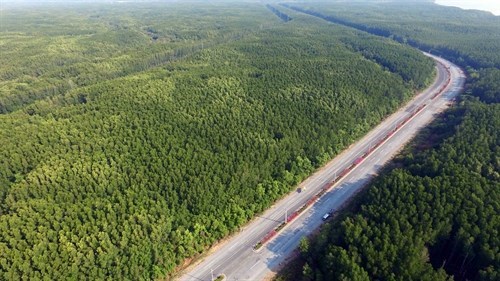 Environment
Environment

 |
| A view of Cần Giờ Mangrove Mangrove Biosphere Reserve in HCM City, which has been nominated to become a Ramsar site in Việt nam. — VNA/VNS Mạnh Linh |
HCM CITY — The Cần Giờ Mangrove Biosphere Reserve in HCM City’s outlying Cần Giờ District has been nominated to become a Ramsar site, a wetland of international importance under the Ramsar Convention.
The municipal People’s Committee has sent a dispatch to the Ministry of Natural Resources and Environment asking it to issue guidelines enabling the administration to complete procedures and necessary work for the nomination.
The Cần Giờ Mangrove Biosphere Reserve meets the requirements to be designated a Ramsar site which makes it eligible for the nomination, according to the reserve’s management board.
The Ramsar Convention is an international treaty on the conservation and sustainable use of wetlands of international importance, especially as a waterfowl habitat. It was signed in 1971 in Ramsar, Iran.
The recognition of the Cần Giờ Mangrove Biosphere Reserve as a Ramsar site is expected to enhance the city's credibility in expanding domestic and international cooperation in the effective management of wetlands.
It will increase technical support capabilities, provide international assistance for biodiversity conservation projects and wetland management, and offer advanced training to officials and civil servants in related fields.
With an area of nearly 35,000 hectares, Cần Giờ mangrove forest was formed and developed on the alluvial ground brought and deposited by the Sài Gòn and Đồng Nai river systems.
The area gradually formed ground, combined with the tropical monsoon climate, the semi-diurnal tidal regime, and the dense network of rivers and canals, creating favorable conditions for the development of the mangrove ecosystem.
It contains a sample of unique, rare, and representative natural or near-natural wetlands within a biogeographic region. It features diverse and rich ecosystems and serves as a habitat and living space for many valuable wild plant and animal species.
It is home to various rare fauna species listed as endangered and also a sanctuary for about 20,000 birds. It also provides a crucial food source for fish, acts as a spawning ground, a nursery, and a migratory route, enabling fish species to thrive within the wetland area.
It contributes significantly to the city’s socio-economic growth and scientific knowledge, environmental protection, and the stability of the livelihoods of local residents and neighbouring localities.
It was recognised as the first international biosphere reserve in the country by the United Nations Educational, Scientific and Cultural Organisation (UNESCO) in early 2000.
The country now has nine wetlands recognised as Ramsar sites, including Xuân Thủy National Park in Nam Định Province, Bàu Sấu in Cát Tiên National Park in Đồng Nai Province, Ba Bể Lake in Bắc Kạn Province, Tràm Chim National Park in Đồng Tháp Province, U Minh Thượng National Park in Kiên Giang Province, Côn Đảo National Park in Bà Rịa-Vũng Tàu Province; Láng Sen Wetland Reserve in Long An Province, Mũi Cà Mau National Park in Cà Mau Province, and Vân Long Wetland Nature Reserve in Ninh Bình Province.
It targets to have 13 Ramsar sites by 2025.
The city plans to turn Cần Giờ District into an ecological urban area as part of efforts to urbanise it and improve the quality of life for locals.
A coastal district located 50km from the city centre, Cần Giờ has a total area of more than 70,412ha, including the mangrove forest.
With a 13-km coastline and extensive mangrove forest intertwined with a dense system of rivers, canals and diverse flora and fauna, Cần Giờ has huge potential to develop eco-tourism, community-based tourism, and resort tourism, experts say. — VNS




